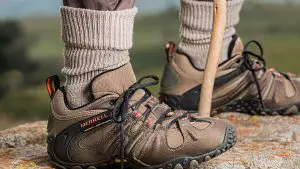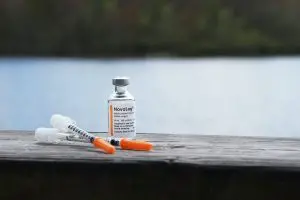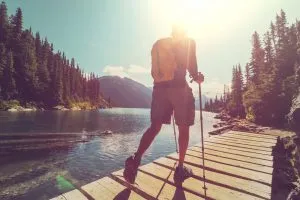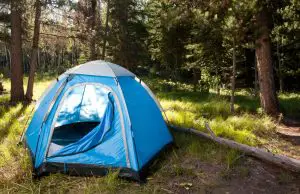How to Purify Water While Hiking
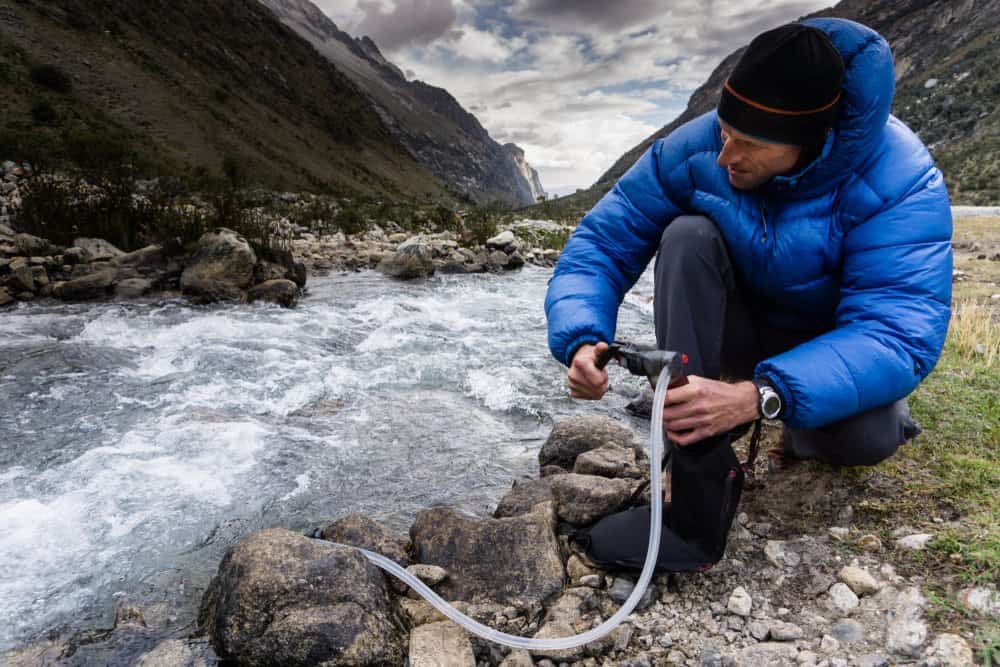
There’s nothing like the peace of mind that comes with knowing you’re carrying enough water for your hike. But what happens when you run out, or if the water in the stream looks a little too murky to drink? Here’s a guide on how to purify water while hiking, so you can stay hydrated and safe on your next adventure.
Quick Links
Why Do You Need To Purify Water?
First off, let’s discuss the importance of purifying water.
Whether you’re hiking in the backcountry or traveling to a foreign country, you must take steps to purify any water you plan on drinking. Unfiltered water can contain harmful bacteria and viruses that can make you sick. In some cases, these illnesses can be deadly. In short, unfiltered water is one of the biggest dangers to hiking for the unprepared.
While most municipal water sources in the United States are treated and safe to drink, this isn’t always the case in other parts of the world. Even if the water looks clean, it can still be contaminated with harmful microorganisms.
Likewise, water from natural sources like lakes, rivers, and streams can also contain bacteria and viruses that can make you sick. In fact, according to the CDC, recreational water — including water in hot springs, swimming pools, and even the ocean — is one of the most common sources of outbreaks of diarrheal illness in the United States.
The best way to protect yourself from these illnesses is to purify any water you plan on drinking.
There are a few different ways to purify water, each with its pros and cons. Let’s take a look at a few of the most popular methods.
Is there a difference between filtering and purifying water?
Yes, there is a difference between filtering and purifying water. Filtering water will remove some impurities, like sediment and bacteria, but it will not remove all of them. Purifying water will remove all impurities, including viruses and other harmful contaminants. Purifying water typically works through a chemical process such as iodine, chlorine, or UV treatment.
However, both are considered to be effective at making water safe to drink on the trails. We will cover different methods to filter and purify your water in the next section.

How Do You Filter And Purify Water When Hiking?
Boiling Water
One of the simplest and most effective ways to purify water is to boil it for at least one minute. This will kill any harmful bacteria or viruses in the water.
Of course, boiling water requires access to a heat source, so it’s not always practical when you’re out on the trail. If you do have a stove, though, boiling is a great option.
Just keep in mind that boiling water will not remove any sediment or other particles from the water. If the water is particularly murky, you may want to strain it through a coffee filter or clean cloth before boiling.
My recommendation for boiling water while hiking is the Coleman Gas Camping Stove. Coleman makes some of the best camping stoves you can find. Purifying water with a portable stove is quick and easy.
Gravity Filter
Gravity filters are one type of water filter that can be particularly useful when hiking. These devices rely on gravity to draw water through a filter, so they can be used without any electricity or pumps.
Gravity filters are typically very effective at removing bacteria and viruses from water. However, they may not remove all of the sediment, so the water may still look cloudy.
My recommendation is the Platypus GravityWorks Water Filter. It may be a bit too much for a solo trip, but the quality is fantastic and is definitely worth the price.
Squeeze Filter
Squeeze filters are another option that can be used to filter water when hiking. These devices rely on a small hand pump to force water through a filtering system.
Squeeze filters are typically very effective at removing bacteria, viruses, and sediments from water. However, they can be more difficult to use than gravity filters, and they require a bit more effort to pump the water through.
When it comes to a squeeze filter, the Sawyer Products Squeeze Water Filter is my go-to. It’s affordable, lightweight, and one of the most popular water filters out there, period.
Pump Water Filter
Pump filters are similar to squeeze filters, but they rely on an electric pump to force the water through the filter.
They are typically very effective at removing bacteria, viruses, and sediments from water. However, they can be more challenging to use than gravity filters or squeeze filters, and they require access to electricity.
My recommendation for a good pump filter is the Katadyn Hiker Pro Water Filter. The pump is small and lightweight but works very well.
Water Purification Tablets
If you’re looking for a lightweight and compact solution, water purification tablets may be the way to go. These tablets contain chemicals that will kill bacteria and viruses in water.
Purification tablets are a great option if you’re concerned about weight and space, but they can take up to 30 minutes to work. Additionally, they may leave a slight chlorine taste in the water.
Although I don’t use water purification tablets often – I have friends who have recommended these Water Purification Tablets by Potable Aqua. They are the most affordable option, and one bottle comes with 50 tablets.
Chemical Treatments
Another option for purifying water is to treat it with chemicals. The most common chemical used for this purpose is iodine, although UV treatment and chlorine can be used as well.
Iodine can be used to purify water in two different ways. The first is to add iodine tablets to the water and let them dissolve. This will kill any harmful bacteria or viruses in the water.
The second way to use iodine is to add it directly to a filter. This will help to remove any bacteria or viruses that the filter doesn’t catch.
Iodine is a very effective water purification method, but it does have some drawbacks. The biggest downside is that it can make the water taste unpleasant. Some people also experience side effects like stomach upset when they drink iodine-treated water.
If you’re going to use iodine to purify water, it’s important to use it correctly. Be sure to follow the directions on the package carefully.
When Should You Purify Water?
Whenever you plan to drink water from a source other than a municipal water system, it’s good to purify it first. This includes water from lakes, rivers, streams, and even rainwater.
It’s also a good idea to purify water if you’re traveling to an area where the local water quality is unknown. This is especially important if you’re going to be in a developing country, where waterborne illnesses are more common.
As discussed above, there are several different ways to purify water, each with its own set of pros and cons. The best method for you will depend on your specific needs and circumstances.
No matter which method you choose, purifying your water is the best way to protect yourself from waterborne illnesses. So, when in doubt, purify!
How do Water Filters Work?
Water filters work by removing impurities from water using a physical barrier, chemical process, or biological process. Filters can be designed to remove specific impurities or general types of impurities.
Besides outdoor use, water filters are used in various settings, including homes, businesses, and public water systems. There are many different water filters, each designed to remove different kinds of impurities.
One of the most common water filters is the activated carbon filter. Activated carbon filters work by adsorbing impurities onto the surface of the carbon. The carbon in these filters is usually made from coconut shells or coal. Activated carbon filters are effective at removing a variety of impurities, including chlorine, pesticides, and herbicides.
Another common type of water filter is the reverse osmosis filter. Reverse osmosis filters work by forcing water through a semi-permeable membrane. The pores in the membrane are small enough to allow water molecules to pass through, but not impurities. This type of filter is effective at removing many different types of impurities, including salts, metals, and chemicals.
There are also biological water filters, which use living organisms to remove impurities from water. These filters can be used to remove bacteria, viruses, and other microorganisms from water. Biological filters are often used in public water systems to disinfect water.
How to Pre-filter Water for Backpacking
So, what does it mean to pre-filter water? Pre-filtering works to eliminate any contaminants BEFORE it goes through the primary water filter. The idea is to make the water filtration process more efficient by removing anything that can be taken care of ahead of time.
There are a few different ways to pre-filter water, each with its own pros and cons.
One common way to pre-filter water is to use a coffee filter. Coffee filters are effective at removing sediment, dirt, and other particulate matter from water. They are also effective at removing some bacteria, viruses, and other microorganisms. The downside to this method is that coffee filters can clog quickly, so they may need to be replaced often.
Another way to pre-filter water is to use a UV water purifier. UV water purifiers work by exposing water to ultraviolet light. This kills bacteria, viruses, and other microorganisms. The downside to this method is that it does not remove sediment, dirt, or other particulate matter from water.
The best way to pre-filter water depends on the type of impurities you are trying to remove. If you are only concerned with removing sediment, dirt, and other particulate matter, then letting the water sit or using a coffee filter should be sufficient. If you are also concerned with removing bacteria, viruses, and other microorganisms, then using a UV water purifier is your best option.
Is It Worth It Getting A Water Filter For Hiking?
So, the question remains. Is it worth it to get a water filter? If you plan on camping overnight or hiking longer than 3-4 hours, I would highly suggest getting a water filter.
I know it may seem like overkill for shorter hikes, but I always like to prepare for the worst-case scenario. Can you imagine getting stuck in the middle of nowhere with NO water? The last thing you want is to run out of clean water and have to drink from a dirty river. Not only could this make you sick, but it could also lead to dehydration.
How Do You Naturally Filter Water?
Okay, so let’s say the worst-case scenario does happen, and you have no water filter available. Is it possible to naturally filter water? Yes, it is possible to naturally filter water, but it requires a bit of effort and time.
One way to naturally filter water is to let it sit. This will allow sediment, dirt, and other particulate matter to settle to the bottom of the container. Once the water has settled, you can carefully pour it into another container, leaving the sediment behind.
Another way to naturally filter water is to use charcoal. Charcoal can be used to remove impurities from water. The first step is to make a char cloth. This can be done by burning cotton fabric in a low oxygen environment (such as in a can). Once the fabric has turned black, it is ready to use.
To use the char cloth, simply place it in a water container and allow it to sit for a few minutes. The charcoal will absorb impurities from the water, making it safe to drink.
Can Banana Peels Filter Water?
Banana peels can be used to filter water. The first step is to cut the peel into thin strips. Next, place the strips in a container of water and allow them to sit for a few minutes. The banana peel will absorb impurities from the water, making it safe to drink.
While banana peels are effective at filtering water, they are not as effective as other methods. This is because banana peels only remove a small amount of impurities from water. If you are looking for a more effective way to filter water, I would suggest using a coffee filter or a UV water purifier.
Conclusion
Learning how to purify your water out on the trails is one of Learning how to purify your water out on the trails is one of the most important skills you can learn. Hiking provides the perfect opportunity to learn about water purification. Not only do you have direct access to different types of water sources, but you can also experiment with different methods of purifying and using a filter on that water.
What is your favorite way to purify water while hiking?

